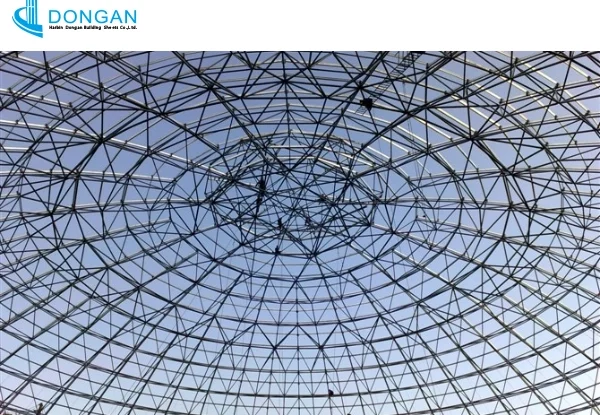
1. What is a grid structure?
A grid structure is a type of steel structure composed of linear members. These members interconnect in a geometric pattern to form a strong and efficient space frame system. Engineers widely use grid structural systems to construct large-span buildings, such as sports stadiums, airport terminals, and exhibition centers, where traditional beam-column systems prove inefficient or impractical.
The orthogonal grid system stresses equally on numerous components and provides optimum utilization of material with the assured stability of the structure. The strength is due to the triangular or orthogonal form of geometry and can support all types of stress, including tension, compression, and bending.
2. Characteristic of grid structure
Compared with conventional building systems, the steel grid structure system possesses the following superior advantages:
- Light strength: Geometric efficiency provides a high strength-to-weight ratio, with greatly reduced material consumption.
- Large span ability: Span long distances without the need to add in-between members, suitable for sports stadiums and factory buildings.
- Modular prefabrication: The workshop can prefabricate members and quickly install them on site, shortening construction time.
- Aesthetic adaptability: Architects can create geometric patterns to architecturally contain and define spaces with a strong visual effect.
- Seismic and disaster-resistant: Steel grid with anti-corrosion coating is earthquake, fire (with protection of coating), and corrosion-resistant.
All the above characteristics render the grid structure one of the first-generation structures in modern projects and architectural buildings.
3. Grid structure type
Depending on the shape and pattern of stress geometry, the grid structure is more appropriately known as:
- Space frame grid structure
Three-dimensional crossing bars with grid structural system to span enormous lengths with fewer built-in supports, characteristic of awning and roof forms.
- Single-Layer Grid Structure
The economically oriented single-plane structural concept is most suitable for small-span structures that focus on economic efficiency.
- Double-Layer Grid Structure
Upper and lower grids with layers and vertical/diagonal connectors constitute the load-carrying capacity and are used extensively in high-span buildings such as airports and exhibition halls.
- Braced Barrel Vault Grid
The structural layout of the grid structure is an arc type, which is best applied in spaces such as hangars and theaters where there is a requirement for a curved roof, and achieves structural efficiency and elegance.
- Free-Form Grid Structure
With the help of computer design technology, steel grid structures can achieve complex organic shapes, giving architects full freedom of design.
4. Uses of Grid Structure Systems
Grid systems are employed in most industries:
- Recreation and Sports: Steel grid systems imitate the long-span feature in concert halls, stadiums, and swimming pools.
- Transportation Buildings: Grid roofs provide expansive, column-free spaces in railway stations, bus terminals, and airports
- Industrial Buildings: Factories and warehouses require enormous open space, and as such, grid systems are economical.
- Commercial Spaces and Exhibition Areas: Grid floor plans are effective both in appearance and functionality in commercial offices as well as exhibition halls.
- Architectural and Cultural Icons: Sophistication of grid system architecture is also evident in world-famous buildings like the Louvre Pyramid and the Eden Project.
5. Conclusion
The steel grid structure system is not just an engineering success but also an architectural wonder. Grid structures can span vast distances using less material. They face repeated loads of design with finesse. So popular are they in modern construction methods. From monolithic sport stadiums to railway stations, even monolithic memorial statues, grid structures keep pushing the limits in structural design.
Technology continues to advance. Green materials and computer modeling will utilize grid systems in buildings in the future. There is an important part for architects and engineers to play. They need to learn these systems. They can only design pretty, affordable, and durable buildings afterwards.






